Last Updated on 6 months by Francis
Rosacea is a skin condition that affects millions of people around the world. It causes redness, inflammation, and discomfort, and can be difficult to treat. While there are many treatment options available, one that has gained popularity in recent years is light therapy. Specifically, blue and red light therapy have been shown to be effective in reducing the symptoms of rosacea and improving overall skin health.
But which color light therapy is best for rosacea? In this article, we’ll explore the differences between blue and red light therapy and help you determine which option might be most suitable for your individual condition. We’ll also discuss various at-home and professional light therapy treatments available, and provide tips on how to use light therapy effectively for rosacea relief.
Contents
Key Takeaways:
- Blue and red light therapy are effective options for treating rosacea.
- The benefits of blue light therapy include killing bacteria and reducing inflammation.
- The benefits of red light therapy include stimulating collagen production and improving skin tone.
- Factors to consider when choosing the right light therapy option include symptom severity, cost, and personal preferences.
- Consistent and appropriate use of light therapy can help alleviate symptoms and improve overall skin health.
Understanding Rosacea and its Treatment Options
If you’re one of the estimated 16 million Americans who suffer from rosacea, you know that this chronic inflammatory condition can be frustrating and uncomfortable. While there’s no cure for rosacea, there are a variety of treatment options available that can help alleviate symptoms and improve your skin’s appearance.
The first step in finding the right treatment for your rosacea is understanding the condition itself. Rosacea is a skin disorder that usually occurs in people over the age of 30. It’s characterized by redness on the face, particularly on the cheeks, nose, and forehead, as well as acne-like pimples, visible blood vessels, and a burning or stinging sensation.
There’s no one-size-fits-all approach to treating rosacea, as the condition can vary widely from person to person. However, some common treatment options include prescription creams and antibiotics, laser therapy, and light therapy.
Light therapy, in particular, has become an increasingly popular treatment option for rosacea in recent years. It’s a non-invasive, painless treatment that uses specific wavelengths of light to target and reduce inflammation in the skin.
If you’re considering light therapy for your rosacea, it’s important to understand the different options available so that you can choose the treatment that’s right for you. Let’s take a closer look at how light therapy can be used as a treatment for rosacea, as well as some of the most effective light therapy solutions for this condition.
What is Blue Light Therapy for Rosacea?
Blue light therapy is a non-invasive light therapy treatment that uses blue light to reduce inflammation and redness associated with rosacea. It works by targeting the bacteria that can exacerbate rosacea symptoms, effectively killing them and preventing further flare-ups. Blue light therapy is a safe and effective solution for those looking for an alternative to traditional rosacea treatments.
Blue light therapy is a type of phototherapy that uses specific wavelengths of light to activate the body’s natural healing process, triggering the release of anti-inflammatory substances in the skin. By reducing inflammation, blue light therapy can help alleviate the symptoms of rosacea, including redness and swelling.

According to recent studies, blue light therapy has shown promising results in reducing the symptoms of rosacea. For example, a study by the American Academy of Dermatology found that blue light therapy was effective in reducing both the erythema (redness) and papules and pustules (bumps and pimples) associated with rosacea.
Blue light therapy is also a safe and painless treatment option, with no known side effects or risks associated with its use. It is a convenient treatment option as well, as it can be used in the comfort of your own home using specialized devices or as part of a professional treatment plan.
Benefits of Blue and Red Light Therapy for Rosacea
Both blue and red light therapy offer unique benefits for treating rosacea, making them two of the most commonly recommended light therapy treatments for this condition. Here are some of the advantages of using blue and red light therapy for rosacea relief:
Benefits of Blue Light Therapy for Rosacea
Blue light therapy is particularly effective for reducing inflammation and killing the bacteria that can contribute to rosacea flare-ups. In fact, research has shown that blue light therapy can be highly effective in reducing the symptoms of rosacea, including redness, swelling, and bumps.
Additionally, blue light therapy is safe, non-invasive, and requires no downtime, making it a convenient and accessible treatment option for ongoing rosacea management.
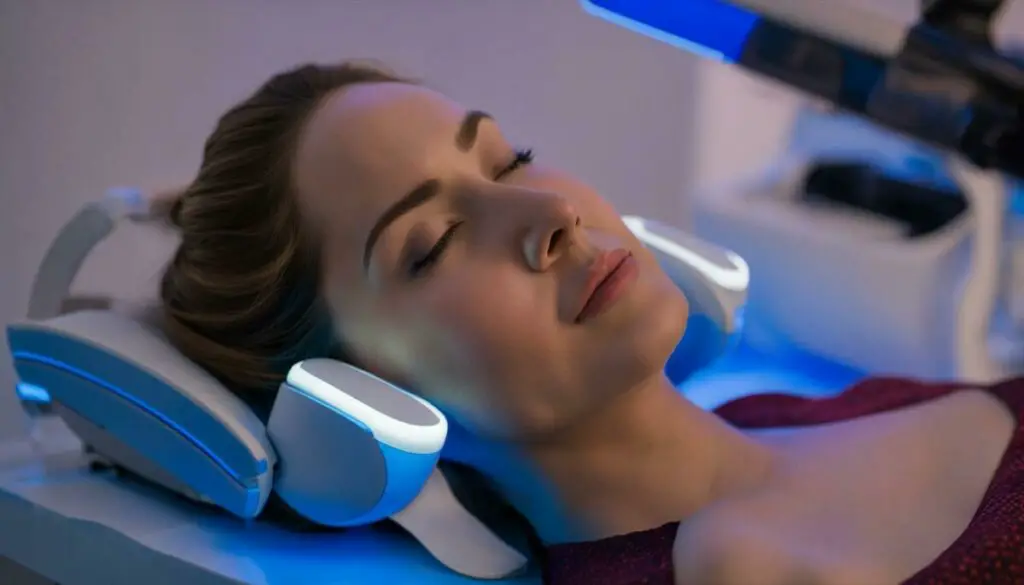
Benefits of Red Light Therapy for Rosacea
Red light therapy is another effective treatment option for rosacea, with the ability to reduce redness, improve skin tone, and promote overall skin health and rejuvenation. Unlike blue light therapy, which primarily targets bacteria and inflammation, red light therapy works by stimulating collagen production and increasing blood flow to the skin, helping to repair damaged tissues and promote healing.
Red light therapy is also safe, non-invasive, and has no known side effects, making it a popular choice for those seeking a natural and non-invasive rosacea treatment.
Whether you choose blue or red light therapy for your rosacea treatment, both options offer a range of benefits that can help alleviate symptoms and improve your overall skin health.
What is Red Light Therapy for Rosacea?
If you’re looking for an effective light therapy solution for your rosacea, you may want to consider red light therapy. This treatment involves the use of low-level red light wavelengths to penetrate the skin, boosting cellular activity and promoting healing. Red light therapy is thought to be particularly beneficial for conditions like rosacea, which causes redness and inflammation in the skin.
During a red light therapy session, patients sit in front of a specialized device that emits red light waves. The light penetrates the skin, triggering a response in the body that can help reduce inflammation and promote healing.
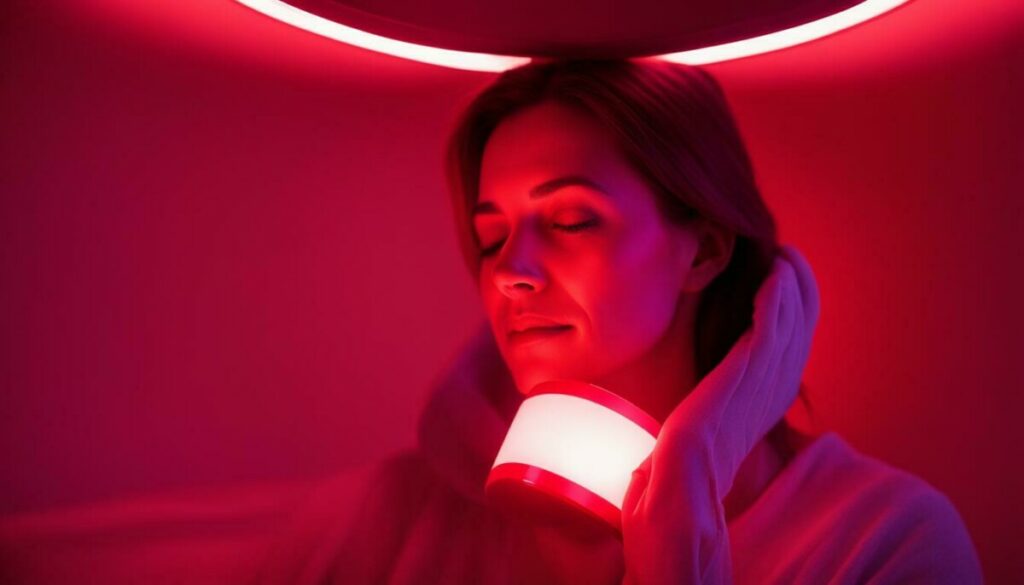
Although red light therapy is still a relatively new treatment option, it has already gained popularity among people with rosacea and other skin conditions. The treatment is non-invasive and does not require any downtime, making it an attractive option for those seeking a convenient and effective skincare solution.
Benefits of Red Light Therapy for Rosacea
Red light therapy has emerged as a promising treatment option for people with rosacea. Here are some of the key benefits of using red light therapy to manage your symptoms:
| Benefit | Description |
|---|---|
| Stimulates collagen production | Red light therapy can help stimulate collagen production in the skin, which can improve skin texture and reduce the appearance of fine lines and wrinkles. |
| Reduces inflammation | Studies have shown that red light therapy can help reduce inflammation, redness, and swelling associated with rosacea. |
| Promotes overall skin rejuvenation | Red light therapy can promote overall skin rejuvenation by increasing blood flow, improving skin tone, and boosting natural cellular activity. |
If you are considering using light therapy to manage your rosacea symptoms, it is important to consult with a healthcare professional to determine the most suitable option for your individual condition. With the help of your healthcare provider, you can find a treatment plan that includes the right type of light therapy and frequency to achieve the most effective results.
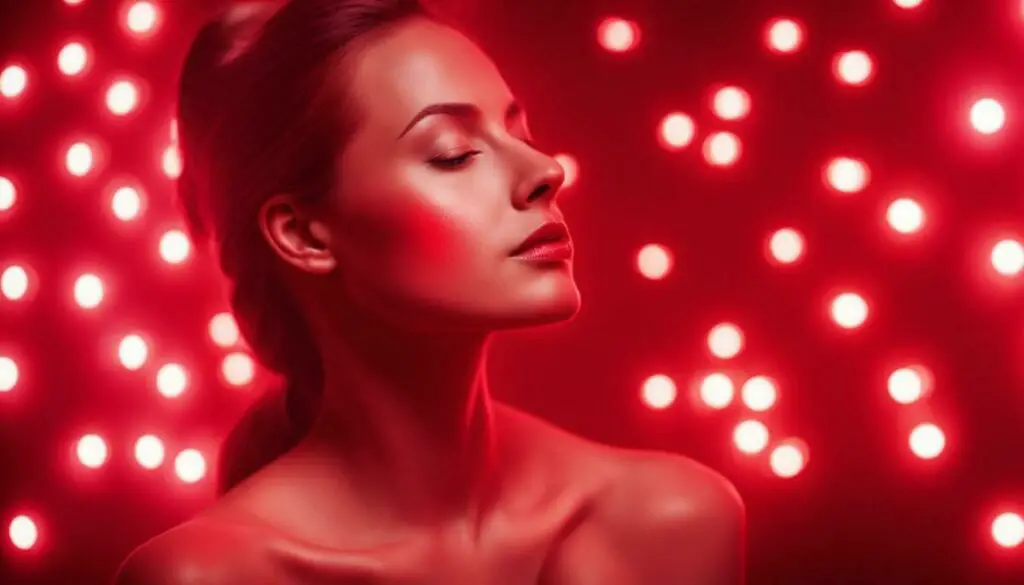
Blue vs. Red Light Therapy for Rosacea
If you’re considering light therapy for your rosacea, you may be wondering: blue or red light therapy – which is best? While both types of light therapy offer unique advantages, the answer depends on your individual situation and the severity of your symptoms.
Blue light therapy has been shown to effectively kill the bacteria that cause acne and rosacea, while also reducing inflammation and redness associated with the condition. This type of therapy is often recommended for patients with mild to moderate rosacea symptoms.
Red light therapy, on the other hand, is known to stimulate collagen production and promote skin rejuvenation, while also reducing redness and improving overall skin tone. This makes it a great option for patients with more advanced rosacea symptoms or those looking to improve the appearance of their skin.
Ultimately, the best light therapy for your rosacea will depend on a variety of factors, including the severity of your symptoms, the location of the affected area, and your personal preferences. Your healthcare professional can help you determine the right treatment plan for your individual situation.
When considering blue vs. red light therapy for rosacea, it’s important to note that some devices offer both options, allowing you to customize your treatment plan based on your needs. Additionally, many patients find that a combination of both blue and red light therapy provides the most comprehensive relief and improvement in their symptoms.
| Factors to Consider When Choosing Light Therapy for Rosacea |
|---|
| Severity of your symptoms |
| Location of the affected area |
| Personal preferences |
Consult with your healthcare professional to determine the most suitable light therapy option for your individual condition. They can help you choose the right device, treatment plan, and schedule to achieve the best possible results.
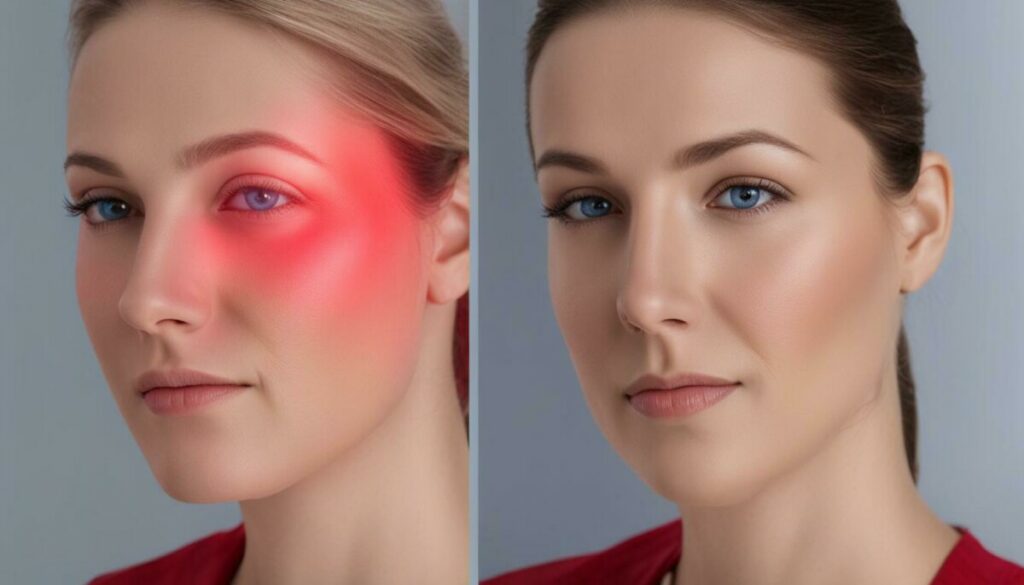
Top Light Therapy Options for Rosacea
There are several light therapy options available for treating rosacea, but some stand out for their effectiveness and convenience. Here are some of the top light therapy solutions for rosacea:
1. Blue Light Devices
Blue light devices use a specific wavelength of light to target and kill the bacteria that contribute to rosacea symptoms. They are effective in reducing inflammation and redness associated with the condition. Some popular blue light devices include the Neutrogena Light Therapy Acne Treatment Mask and the Tria Beauty Positively Clear Acne Clearing Blue Light Device.
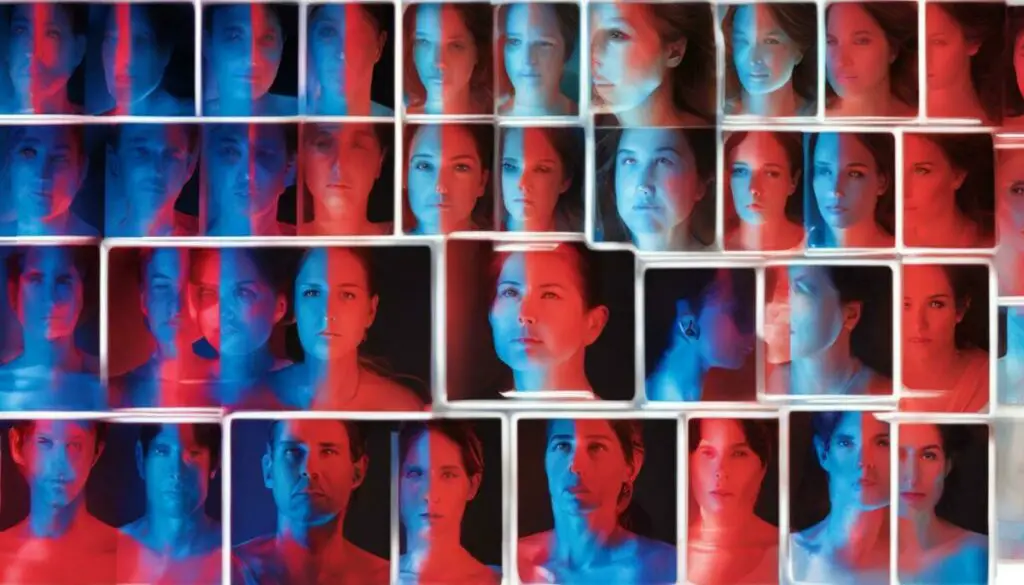
2. Red Light Devices
Red light devices use a different wavelength of light to improve skin tone, promote healing, and reduce redness associated with rosacea. They are also effective in stimulating collagen production and promoting overall skin rejuvenation. Some popular red light devices include the LightStim for Wrinkles LED Light Therapy Device and the Beurer IL50 Infrared Heat Lamp.
3. Combination Devices
Combination devices offer both blue and red light therapy, providing a comprehensive approach to treating rosacea. By targeting both bacteria and inflammation, combination devices can provide more effective relief for rosacea symptoms. Some popular combination devices include the ReVive Light Therapy dpl IIa Professional Wrinkle Reduction and Acne Treatment Light Therapy and the NORLANYA Photon Therapy LED Facial Mask.
Choosing the right light therapy option for your rosacea treatment will depend on various factors, such as the severity of your symptoms, cost, convenience, and personal preferences. Consult with a healthcare professional to determine which light therapy treatment is best for your individual condition.
How to Choose the Right Light Therapy for Rosacea
With so many different light therapy options available for treating rosacea, it can be difficult to determine which one is right for you. Here are some factors to consider when choosing the right light therapy for your individual condition:
Severity of Your Symptoms
The severity of your rosacea symptoms, such as the level of redness, inflammation, and visible blood vessels, will play a significant role in determining which type of light therapy is right for you.
If your symptoms are mild to moderate, you may be a good candidate for at-home light therapy devices, such as handheld devices or light therapy masks. However, if your symptoms are severe or persistent, you may require more targeted and intensive treatment, such as in-office light therapy sessions.
Cost
Light therapy treatments can vary in cost depending on the type of device or treatment you choose, as well as whether you choose to receive professional treatments or use at-home devices. Consider your budget when choosing the right light therapy option for your rosacea.
Convenience
Consider how much time and effort you are willing to commit to your light therapy treatment routine. In-office light therapy sessions may require more time and travel, while at-home devices may be more convenient and accessible for your daily routine.
Personal Preferences
Some people may prefer the simplicity and ease of at-home light therapy devices, while others may prefer the expertise and guidance of professional light therapy treatments. Consider your personal preferences when choosing the right light therapy for your rosacea.
By taking these factors into account, you can find the most effective and suitable light therapy solution for your individual rosacea condition.

Using Blue and Red Light Therapy for Rosacea Relief
If you suffer from rosacea, incorporating blue and red light therapy into your skincare routine can help alleviate symptoms and promote overall skin health. Both blue and red light therapy are effective light therapy solutions for rosacea, offering unique benefits and advantages.
| Blue Light Therapy | Red Light Therapy |
|---|---|
|
|
The best way to use blue and red light therapy for rosacea relief is to incorporate it as part of your regular skincare routine. You can use handheld devices or light therapy masks, or visit a professional for in-office sessions. It’s important to follow recommended treatment duration and frequency, which may vary depending on the severity of your symptoms and the type of light therapy device.
In addition to using light therapy, it’s important to take other measures to manage your rosacea symptoms. This may include avoiding triggers such as spicy foods and alcohol, using gentle skincare products, and protecting your skin from the sun.
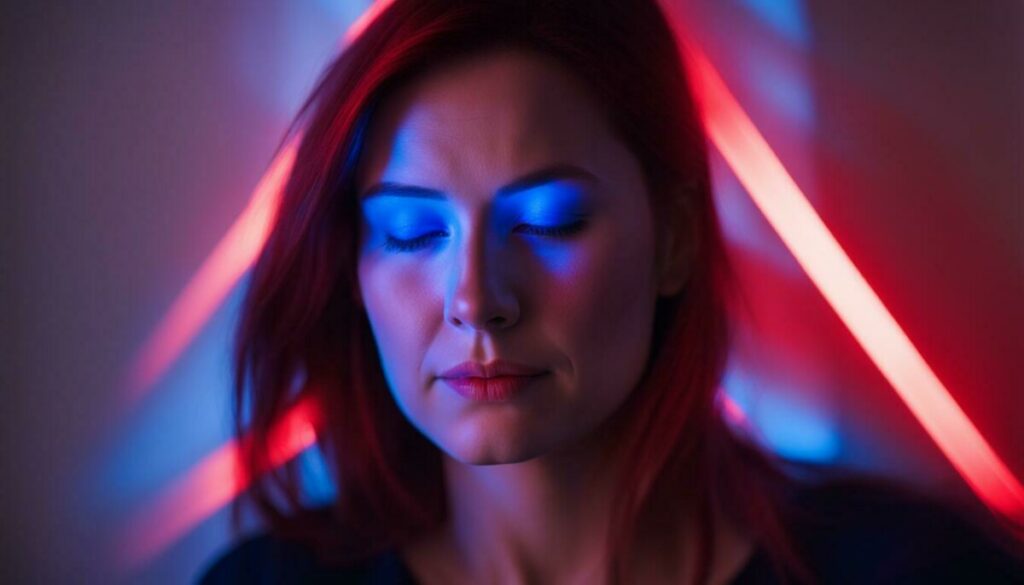
By using blue and red light therapy for rosacea relief, you can effectively manage your symptoms and improve your overall skin health. Consult with a healthcare professional to determine the most effective light therapy solution for your individual condition and incorporate it into your regular skincare routine for consistent and convenient treatment.
Professional Light Therapy Treatments for Rosacea
If you’re seeking targeted and effective relief for your rosacea symptoms, professional light therapy treatments may be a suitable option for you. These treatments are typically administered in-office by a healthcare professional and utilize specialized equipment to deliver blue or red light therapy to the affected areas of your skin.
One of the most popular professional light therapy treatments for rosacea is IPL (intense pulsed light) therapy, which uses a combination of different wavelengths of light to target redness, inflammation, and visible blood vessels. IPL therapy has been shown to provide significant improvement in rosacea symptoms, and most patients experience little to no discomfort during the treatment.
Another option is PDL (pulsed dye laser) therapy, which uses a concentrated beam of yellow light to target visible blood vessels and reduce redness and inflammation. PDL therapy is particularly effective for treating visible blood vessels and can provide long-lasting relief for rosacea patients.
| Treatment Type | Benefits |
|---|---|
| IPL Therapy | – Reduces redness and inflammation – Targets visible blood vessels – Provides significant improvement in symptoms |
| PDL Therapy | – Targets visible blood vessels – Reduces redness and inflammation – Provides long-lasting relief for rosacea |
While professional light therapy treatments may be more expensive than at-home solutions, they can provide highly effective and targeted relief for moderate to severe cases of rosacea. It’s important to consult with a healthcare professional to determine if professional light therapy is right for you and which specific treatment option would be most suitable for your individual condition.
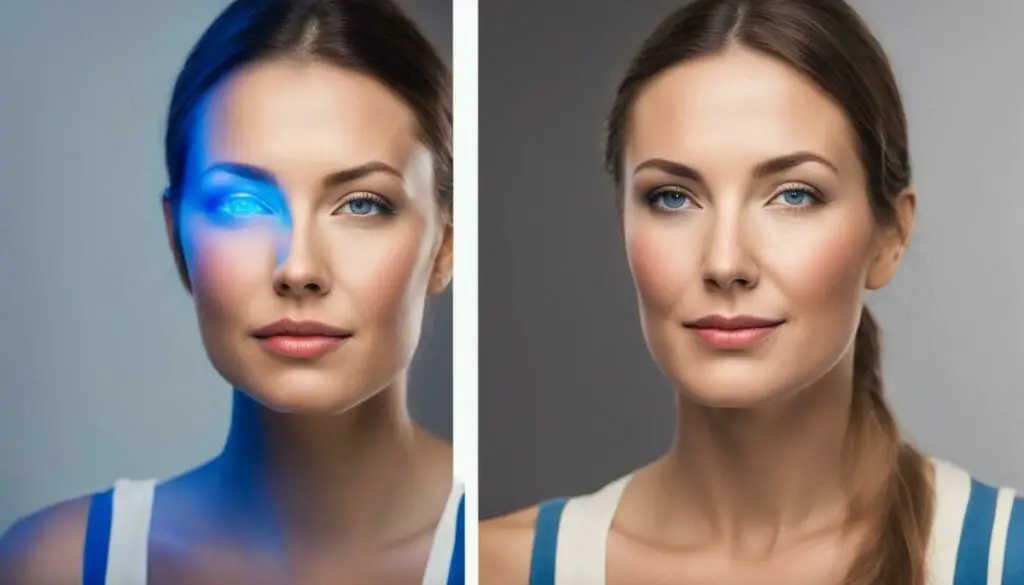
At-Home Light Therapy Solutions for Rosacea
In addition to professional light therapy treatments, there are various at-home light therapy solutions available for rosacea that you can use on your own. These solutions can be used conveniently and on a regular basis, providing consistent relief for your symptoms.
One popular at-home light therapy solution is handheld devices that emit blue or red light. These devices are easy to use and can be used on targeted areas of your skin to alleviate redness and inflammation. They are compact and lightweight, making them perfect for travel or use on the go.
Another at-home option is light therapy masks that use both blue and red light to treat rosacea. These masks are designed to fit over your entire face and provide a more comprehensive treatment experience. Some masks also include additional features such as adjustable intensity settings and built-in timers for precise treatment control.
When using at-home light therapy solutions for rosacea, it is important to follow the manufacturer’s instructions carefully to ensure the best possible results. Additionally, be sure to maintain good skincare practices and protect your skin from sun exposure during and after treatment.
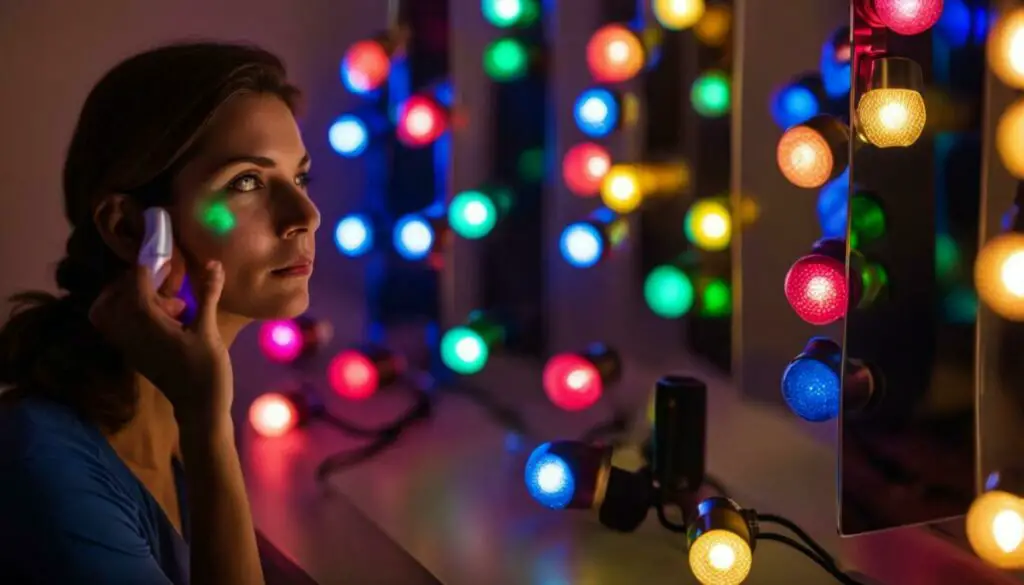
At-home light therapy solutions can be a cost-effective and convenient way to incorporate light therapy into your rosacea treatment routine. However, it is important to note that at-home solutions may not be as effective as professional treatments, and results may vary depending on the severity of your condition.
Ultimately, it is recommended to consult with a healthcare professional to determine the most suitable light therapy option for your individual rosacea condition and to ensure that you are using it safely and effectively.
Tips for Using Light Therapy for Rosacea
If you’re considering using light therapy for rosacea relief, there are a few tips you should keep in mind to ensure the best possible results.
1. Start with a Low Intensity
Whether you’re using blue or red light therapy, it’s recommended that you start with a low intensity and gradually increase the strength of the treatment over time. This can help your skin adjust to the therapy and minimize the risk of any irritation or discomfort.
2. Be Consistent
Consistency is key when it comes to using light therapy for rosacea. Aim to use the treatment daily or as recommended by your healthcare professional to see the best results.
3. Follow Skincare Precautions
Before using light therapy, it’s important to cleanse and dry your skin thoroughly. It’s also recommended that you avoid using any harsh skincare products that could irritate your skin or counteract the effects of the treatment.
4. Protect Your Eyes
When using light therapy for rosacea, it’s important to protect your eyes with goggles or other protective eyewear to prevent any potential damage from the bright light.
5. Consider Combination Therapy
Combining blue and red light therapy may provide even more effective relief for rosacea symptoms. Some devices offer both types of therapy, or you may choose to alternate between the two.
By following these tips, you can use blue and red light therapy as an effective solution for rosacea relief. Consult with your healthcare professional to determine the best light therapy option for your individual condition.

The Future of Light Therapy for Rosacea
As researchers continue to investigate the benefits of light therapy for rosacea, the future looks promising for individuals seeking effective and convenient treatment solutions. Ongoing studies suggest that the use of blue and red light therapy, either as standalone options or in combination with other treatments, can provide significant relief for rosacea symptoms.
Advancements in technology have also led to the development of new and innovative light therapy devices designed specifically for rosacea treatment, including those that utilize high-tech materials, feature customizable settings, and offer a range of wavelengths for optimal results.
Moreover, healthcare professionals are increasingly recognizing the value of light therapy as a safe and noninvasive alternative to traditional treatments, such as medication and surgery. As more people turn to natural and holistic approaches to skincare, light therapy is becoming an appealing option for those seeking a gentle and effective way to address their rosacea symptoms.
With ongoing research and development, it is likely that the future of light therapy for rosacea will continue to expand, offering more effective and personalized treatment options for individuals of all skin types and conditions.
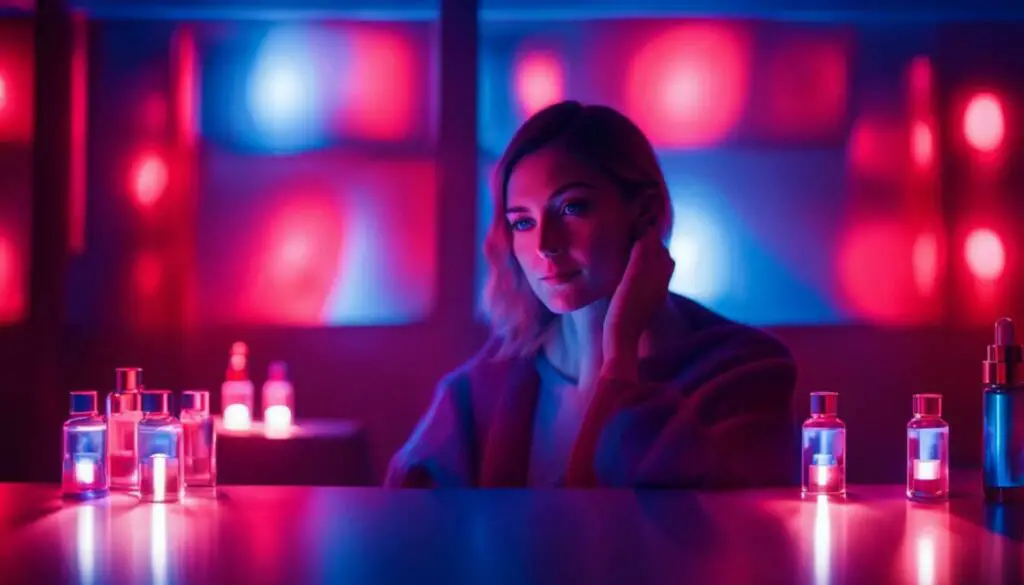
Conclusion
In conclusion, light therapy can be an effective treatment option for rosacea, but choosing the right color and device is crucial for achieving optimal results. Whether you opt for blue light therapy, red light therapy, or a combination device, it’s important to consult with a healthcare professional to ensure that you’re selecting the most suitable option for your individual condition and treatment goals.
Additionally, incorporating at-home light therapy solutions into your daily skincare routine can enhance the effectiveness of professional treatments and help you maintain consistent and convenient treatment. Remember to follow recommended treatment duration and frequency, and take necessary skincare precautions to avoid adverse effects.
Stay Informed about the Latest Innovations
As ongoing research and development continue to advance the field of light therapy, it’s important to stay up-to-date on the latest innovations and emerging treatment options for rosacea. By remaining informed and working closely with a healthcare professional, you can help ensure that you’re receiving the most effective and personalized treatment for your condition.
FAQ
What is the difference between blue and red light therapy for rosacea?
Blue light therapy targets the bacteria that contribute to rosacea symptoms, while red light therapy works to reduce inflammation and promote healing.
Is light therapy a proven treatment for rosacea?
Yes, light therapy has been shown to be effective in reducing redness, inflammation, and other symptoms associated with rosacea.
How often should I use light therapy for rosacea?
The frequency of light therapy treatments can vary depending on the severity of your symptoms. It is best to consult with a healthcare professional to determine the appropriate treatment schedule for your individual condition.
Are there any side effects from light therapy for rosacea?
Light therapy is generally considered safe, but some people may experience temporary redness, dryness, or mild irritation in the treated area. These side effects typically subside shortly after treatment.
Can I use light therapy in combination with other rosacea treatments?
Yes, light therapy can be used in conjunction with other treatments for rosacea, such as topical creams or oral medications. It is important to discuss your treatment plan with a healthcare professional to ensure compatibility and effectiveness.
How long does it take to see results from light therapy for rosacea?
Results can vary depending on the individual and the severity of the condition. Some people may start to notice improvements within a few weeks of regular light therapy treatments, while others may require longer to see significant changes.
Can light therapy be used on all skin types?
Light therapy can be used on most skin types, but it is best to consult with a healthcare professional to determine the suitability of light therapy for your specific skin type and condition.
Can I perform light therapy for rosacea at home?
Yes, there are various at-home light therapy devices available for rosacea treatment. However, it is important to follow the manufacturer’s instructions and consult with a healthcare professional before starting any at-home light therapy treatment.
Is light therapy a permanent solution for rosacea?
Light therapy can provide significant relief from rosacea symptoms, but it is not considered a permanent solution. Regular maintenance treatments may be necessary to maintain the desired results.
How do I choose the right light therapy device for my rosacea?
To choose the right light therapy device for your rosacea, consider factors such as the severity of your symptoms, cost, convenience, and personal preferences. Consulting with a healthcare professional can also help guide you in selecting the most suitable device for your needs.
Can pregnant or breastfeeding women use light therapy for rosacea?
It is best to consult with a healthcare professional before undergoing light therapy for rosacea if you are pregnant or breastfeeding, as there may be potential risks or considerations to take into account.








